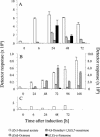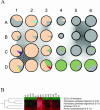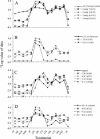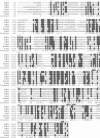Combined transcript and metabolite analysis reveals genes involved in spider mite induced volatile formation in cucumber plants
- PMID: 15310834
- PMCID: PMC520772
- DOI: 10.1104/pp.104.048116
Combined transcript and metabolite analysis reveals genes involved in spider mite induced volatile formation in cucumber plants
Abstract
Many plants have an indirect defense against herbivores by emitting volatiles that attract carnivorous enemies of the herbivores. In cucumber (Cucumis sativus) the production of carnivore attractants can be induced by herbivory or jasmonic acid spraying. From the leaves of cucumber plants with and without spider mite infestation, two subtractive cDNA libraries were made that were enriched in cDNA fragments up- or down-regulated by spider mite infestation. A total of 713 randomly selected clones from these libraries were used to make a cDNA microarray. Subsequently, cucumber plants were sprayed with jasmonic acid, mechanically damaged, infested with spider mites, or left untreated (control). Leaf samples were taken at a range of different time points, and induced volatile compounds and mRNA (from the same leaves) were collected. cDNAs prepared from the mRNA were hybridized to the clones on the microarray. The resulting gene expression profiles were analyzed in combination with volatile production data in order to gain insight in the possible involvement of the studied genes in the synthesis of those volatiles. The clones on the microarray and the induced cucumber volatiles could be grouped into a number of clusters in which specific biosynthetic genes clustered with the product of that pathway. For example, lipoxygenase cDNA clones clustered with the volatile (Z)-3-hexenyl acetate and the volatile sesquiterpene (E,E)- alpha-farnesene clustered with an up-regulated sesquiterpene synthase fragment. This fragment was used to screen a cDNA library which resulted in the cloning of the cucumber (E,E)-alpha-farnesene and (E)-beta-caryophyllene synthases. The use of combined global gene expression analysis and metabolite analysis for the discovery of genes involved in specific biosynthetic processes is discussed.
Figures







Similar articles
-
Genetic variation in jasmonic acid- and spider mite-induced plant volatile emission of cucumber accessions and attraction of the predator Phytoseiulus persimilis.J Chem Ecol. 2010 May;36(5):500-12. doi: 10.1007/s10886-010-9782-6. Epub 2010 Apr 13. J Chem Ecol. 2010. PMID: 20383796 Free PMC article.
-
Transcriptional and metabolite analysis reveal a shift in direct and indirect defences in response to spider-mite infestation in cucumber (Cucumis sativus).Plant Mol Biol. 2020 Jul;103(4-5):489-505. doi: 10.1007/s11103-020-01005-y. Epub 2020 Apr 18. Plant Mol Biol. 2020. PMID: 32306368 Free PMC article.
-
Spider mite-induced (3S)-(E)-nerolidol synthase activity in cucumber and lima bean. The first dedicated step in acyclic C11-homoterpene biosynthesis.Plant Physiol. 1999 Sep;121(1):173-80. doi: 10.1104/pp.121.1.173. Plant Physiol. 1999. PMID: 10482672 Free PMC article.
-
Herbivore-induced defense response in a model legume. Two-spotted spider mites induce emission of (E)-beta-ocimene and transcript accumulation of (E)-beta-ocimene synthase in Lotus japonicus.Plant Physiol. 2004 Aug;135(4):1976-83. doi: 10.1104/pp.104.042929. Epub 2004 Aug 13. Plant Physiol. 2004. PMID: 15310830 Free PMC article.
-
Variation in herbivory-induced volatiles among cucumber (Cucumis sativus L.) varieties has consequences for the attraction of carnivorous natural enemies.J Chem Ecol. 2011 Feb;37(2):150-60. doi: 10.1007/s10886-011-9906-7. Epub 2011 Jan 20. J Chem Ecol. 2011. PMID: 21249432 Free PMC article.
Cited by
-
Identification and validation of the wound and insect bite early inducible promoter from Arabidopsis thaliana.3 Biotech. 2022 Mar;12(3):74. doi: 10.1007/s13205-022-03143-0. Epub 2022 Feb 21. 3 Biotech. 2022. PMID: 35251877 Free PMC article.
-
Simulated herbivory in chickpea causes rapid changes in defense pathways and hormonal transcription networks of JA/ethylene/GA/auxin within minutes of wounding.Sci Rep. 2017 Mar 16;7:44729. doi: 10.1038/srep44729. Sci Rep. 2017. PMID: 28300183 Free PMC article.
-
Comparative analysis of powdery mildew resistant and susceptible cultivated cucumber (Cucumis sativus L.) varieties to reveal the metabolic responses to Sphaerotheca fuliginea infection.BMC Plant Biol. 2021 Jan 7;21(1):24. doi: 10.1186/s12870-020-02797-3. BMC Plant Biol. 2021. PMID: 33413112 Free PMC article.
-
Honing in on phenotypes: comprehensive two-dimensional gas chromatography of herbivory-induced volatile emissions and novel opportunities for system-level analyses.AoB Plants. 2013;5:plt002. doi: 10.1093/aobpla/plt002. Epub 2013 Feb 23. AoB Plants. 2013. PMID: 23444146 Free PMC article.
-
Biochemistry of plant volatiles.Plant Physiol. 2004 Aug;135(4):1893-902. doi: 10.1104/pp.104.049981. Plant Physiol. 2004. PMID: 15326281 Free PMC article. Review. No abstract available.
References
-
- Adams RP (1995) Identification of Essential Oil Components by Gas Chromatography/Mass Spectroscopy. Allured Publishing, Carol Stream, IL
-
- Agrawal AA, Janssen A, Bruin J, Posthumus MA, Sabelies MW (2002) An ecological cost of plant defence: attractiveness of bitter cucumber plants to natural enemies of herbivores. Ecol Lett 5: 377–385
-
- Arimura G, Tashiro K, Kuhara S, Nishioka T, Ozawa R, Takabayashi J (2000) Gene responses in bean leaves induced by herbivory and by herbivore-induced volatiles. Biochem Biophys Res Commun 277: 305–310 - PubMed
-
- Bannai H, Tamada Y, Maruyama O, Nakai K, Miyano S (2002) Extensive feature detection of N-terminal protein sorting signals. Bioinformatics 18: 298–305 - PubMed
Publication types
MeSH terms
Substances
Associated data
- Actions
- Actions
LinkOut - more resources
Full Text Sources
Other Literature Sources
Molecular Biology Databases

